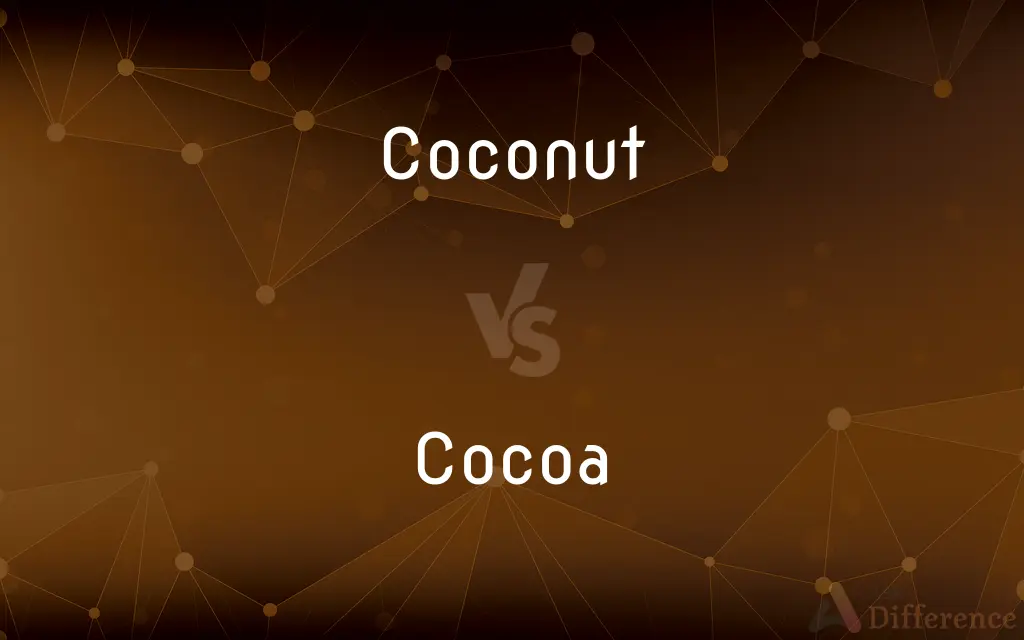Coconut vs. Cocoa — What's the Difference?
Edited by Tayyaba Rehman — By Maham Liaqat — Updated on April 6, 2024
Coconut is a versatile fruit known for its water, milk, and oil, used in culinary and non-food products, while cocoa is a bean used primarily to make chocolate and cocoa products, celebrated for its flavor and health benefits.

Difference Between Coconut and Cocoa
Table of Contents
ADVERTISEMENT
Key Differences
Coconut originates from the coconut palm tree and is celebrated for its versatility, being used in everything from culinary dishes to beauty products. It's known for its distinct flavor and health benefits, such as hydration and antimicrobial properties. Whereas cocoa comes from the seeds of the cacao tree and is most famous for its role in the production of chocolate. Cocoa is rich in antioxidants and is associated with numerous health benefits, including improved heart health and mood enhancement.
The coconut tree provides a variety of products including coconut water, milk, oil, and flesh, making it an integral part of many diets and culinary traditions around the world. Coconut oil, in particular, is used for cooking, skincare, and haircare due to its moisturizing properties. On the other hand, cocoa is primarily processed into cocoa powder and cocoa butter, which are key ingredients in chocolate, baked goods, and some cosmetic products. The flavor of cocoa is a cornerstone of many desserts and sweets.
In terms of cultivation, coconuts are grown in tropical climates around the world, thriving near the sea in sandy soils. They require a humid environment and are found in countries across Asia, Africa, and Latin America. Conversely, cocoa trees also prefer tropical climates but require a more controlled environment, often needing shade and specific humidity levels, which restricts their cultivation to within 20 degrees north and south of the Equator, with major producers including Ivory Coast, Ghana, and Ecuador.
Nutritionally, coconut products are known for their high content of saturated fats, particularly in coconut oil, and are a good source of manganese and fiber. While cocoa is celebrated for its high levels of antioxidants, especially flavonoids, which are believed to have numerous health benefits, including reducing inflammation and improving heart health. Cocoa is also a significant source of iron, magnesium, and zinc.
Culinary uses of coconut include coconut water as a refreshing drink, coconut milk and cream as bases for curries and soups, and grated coconut flesh in desserts and snacks. Coconut oil is also a popular alternative to other cooking oils and fats. Conversely, cocoa is mainly used in sweet dishes and beverages, like chocolate bars, cakes, and hot cocoa. Its bitter taste also makes it suitable for some savory recipes, adding depth and complexity.
ADVERTISEMENT
Comparison Chart
Primary Products
Water, milk, oil, flesh
Cocoa powder, cocoa butter, chocolate
Nutritional Content
High in saturated fats, manganese, fiber
Rich in antioxidants, iron, magnesium, zinc
Health Benefits
Hydration, antimicrobial properties
Improved heart health, mood enhancement
Culinary Uses
Drinks, curries, desserts, cooking oil
Chocolate products, baked goods, some savory dishes
Growth Environment
Tropical climates, near the sea
Tropical climates, requires shade and humidity
Major Producers
Asia, Africa, Latin America
Ivory Coast, Ghana, Ecuador
Compare with Definitions
Coconut
A large fruit from the coconut palm with a hard shell and white flesh.
Coconut water is a popular hydrating drink.
Cocoa
Used to describe a deep brown color.
She chose a cocoa-colored paint for the living room walls.
Coconut
Coconut milk, a creamy liquid made from the flesh, used in cooking.
Coconut milk adds richness to curry dishes.
Cocoa
A powder made from roasted and ground cacao seeds.
She added cocoa to the cake batter for a chocolate flavor.
Coconut
The white, edible flesh of the coconut, often grated for culinary use.
She sprinkled grated coconut over the dessert.
Cocoa
Cocoa butter, a fat derived from cacao beans, used in chocolate making.
Cocoa butter gives chocolate its smooth texture.
Coconut
Coconut water, the clear liquid inside young coconuts, consumed as a beverage.
After his workout, he drank coconut water for hydration.
Cocoa
The bean of the cacao tree, primary ingredient in chocolate.
Cocoa beans are fermented before being processed into chocolate.
Coconut
Coconut oil, extracted from the flesh, used in cooking and cosmetics.
Coconut oil is a key ingredient in many vegan recipes.
Cocoa
A drink made by mixing cocoa powder with milk or water.
He enjoyed a warm cup of cocoa on a cold evening.
Coconut
The coconut tree (Cocos nucifera) is a member of the palm tree family (Arecaceae) and the only living species of the genus Cocos. The term "coconut" (or the archaic "cocoanut") can refer to the whole coconut palm, the seed, or the fruit, which botanically is a drupe, not a nut.
Cocoa
A powder made from cacao seeds after they have been fermented, roasted, shelled, ground, and freed of most of their fat.
Coconut
The fruit of the coconut palm, consisting of a fibrous husk surrounding a large seed.
Cocoa
See hot chocolate.
Coconut
The large, brown, hard-shelled seed of the coconut, containing white flesh surrounding a partially fluid-filled central cavity.
Cocoa
A moderate brown to reddish brown.
Coconut
The edible white flesh of the coconut, often shredded and used in food and confections or for the extraction of coconut oil.
Cocoa
The dried and partially fermented fatty seeds of the cacao tree from which chocolate is made.
Coconut
A coconut palm.
Cocoa
An unsweetened brown powder made from roasted, ground cocoa beans, used in making chocolate, and in cooking.
Coconut
A fruit of the coconut palm (not a true nut), Cocos nucifera, having a fibrous husk surrounding a large seed.
Cocoa
(uncountable) A hot drink made with milk, cocoa powder, and sugar.
Do you like cocoa?
Coconut
A hard-shelled seed of this fruit, having white flesh and a fluid-filled central cavity.
Cocoa
(countable) A serving of this drink.
I like to watch TV with a cocoa.
Coconut
(uncountable) The edible white flesh of this fruit.
Cocoa
A light to medium brown colour.
Coconut
The coconut palm.
Cocoa
Alternative spelling of coco.
Coconut
A Hispanic or other dark-skinned person considered to have overly assimilated to white culture, a race traitor.
Cocoa
Of a light to medium brown colour, like that of cocoa powder.
Coconut
A black person considered to have overly assimilated to white culture, a black race traitor.
Cocoa
A tall palm tree producing the cocoanut (Cocos nucifera) as its fruit. It grows in nearly all tropical countries, attaining a height of sixty or eighty feet. The trunk is without branches, and has a tuft of leaves at the top, each being fifteen or twenty feet in length, and at the base of these the nuts hang in clusters; the cocoanut tree. It is widely planted throughout the tropics, and in some locations as an ornamental tree.
Coconut
A Pacific islander.
Cocoa
A preparation made from the seeds of the chocolate tree, and used in making, a beverage; also the beverage made from cocoa or cocoa shells.
Coconut
(slang) The human head.
Cocoa
A beverage made from cocoa powder and milk and sugar; usually drunk hot
Coconut
The edible white meat of a coconut{3}; often shredded for use in e.g. cakes and curries.
Cocoa
Powder of ground roasted cocao beans with most of the fat removed
Coconut
The cocoa palm.
Coconut
The large, hard-shelled oval nut of the cocoa palm. It has a fibrous husk containing a thick white fibrous meat much used as food, in confections, and in making oil. It has a central cavity filled (when fresh) with an agreeable milky liquid.
Coconut
The edible white meat a coconut; often shredded for use in e.g. cakes and curries
Coconut
Large hard-shelled oval nut with a fibrous husk containing thick white meat surrounding a central cavity filled (when fresh) with fluid or milk
Coconut
Tall palm tree bearing coconuts as fruits; widely planted throughout the tropics
Common Curiosities
Can both coconut and cocoa be used in desserts?
Yes, both are popular in dessert recipes, with coconut providing a creamy texture and tropical flavor, and cocoa offering a rich chocolate taste.
Are coconut and cocoa grown in the same regions?
Both thrive in tropical climates, but their specific cultivation requirements differ, leading to different geographic distributions.
Which is healthier: coconut or cocoa?
Both have health benefits, but cocoa is particularly noted for its antioxidant properties, while coconut provides hydration and antimicrobial benefits.
How do coconut oil and cocoa butter differ in their uses?
Coconut oil is widely used in cooking and skincare, while cocoa butter is a key ingredient in chocolate and some cosmetic products.
What role do coconut and cocoa play in traditional medicine?
Coconut has been used for its antimicrobial and hydration properties, whereas cocoa is valued for its mood-enhancing and heart health benefits.
What is the main difference between coconut and cocoa?
The main difference lies in their sources and primary uses: coconut comes from a palm tree and is used in a variety of foods and products, while cocoa is derived from cacao seeds and is essential in chocolate making.
Can I substitute coconut products for cocoa in recipes?
Substitution depends on the recipe and desired outcome, as they offer different flavors and textures. Coconut can sometimes replace cocoa butter in vegan recipes.
What are the environmental impacts of coconut and cocoa production?
Both industries face challenges like deforestation and labor issues. Sustainable and ethical sourcing practices are important for minimizing environmental impact.
Can people with nut allergies consume coconut or cocoa products?
While coconuts are technically seeds and cocoa beans are seeds, allergies can vary widely. Individuals should consult with a healthcare provider.
How are cocoa beans processed into chocolate?
Cocoa beans are fermented, dried, roasted, and then ground. The resulting cocoa mass can be separated into cocoa powder and cocoa butter, which are then used to make chocolate.
Is there a sustainability concern with coconut and cocoa farming?
Yes, both industries face sustainability challenges, including deforestation and the need for ethical labor practices.
Share Your Discovery

Previous Comparison
Cafe vs. Eatery
Next Comparison
Hail vs. HeilAuthor Spotlight
Written by
Maham LiaqatEdited by
Tayyaba RehmanTayyaba Rehman is a distinguished writer, currently serving as a primary contributor to askdifference.com. As a researcher in semantics and etymology, Tayyaba's passion for the complexity of languages and their distinctions has found a perfect home on the platform. Tayyaba delves into the intricacies of language, distinguishing between commonly confused words and phrases, thereby providing clarity for readers worldwide.














































